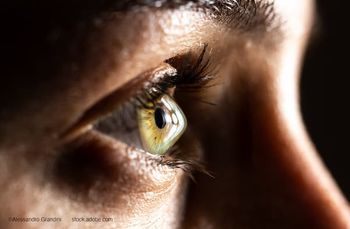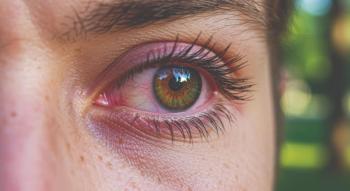
Many eye movement disorders seen with hydrocephalus
Increased intracranial pressure is associated with extraocular motility disturbances.
The relationship between the extent of the eye movement abnormality and the severity and localization of the neurologic insult, however, is unclear, noted Hall, a certified orthoptist from Boulder, CO.
One manifestation, the setting-sun phenomenon, is characterized by conjugate downward deviation of the eyes that may be accompanied by lid retraction.
"However, this disease is not exclusively related to neurologic disease in infants. In 1975, in one study 19 infants with the setting-sun phenomenon were observed for 1 year after birth. Nine of these children had no signs of illness. Ten of the 19 children had increased intracranial pressure; in two of the 10 there was spontaneous resolution and the rest required surgery," she said.
Dorsal midbrain syndrome
Another manifestation, the dorsal midbrain syndrome, was first described in 1886, when Henry Parinaud first differentiated between supranuclear and infranuclear ocular motor palsies. He described a supranuclear paralysis with weak convergence and paralysis of the vertical eye movements.
Based on this, he hypothesized that the lesion was in the dorsal midbrain and not in the ocular motor nerve or nucleus. The syndrome currently is known to be associated with damage in the pretectal area of the dorsal midbrain in close proximity to the pupillary fibers and the vertical upgaze center, Hall explained.
Paralysis of conjugate vertical movements with frequently marked limitation of upgaze characterizes the syndrome. Lid retraction can be observed in primary gaze and exaggerated in upgaze.
Other characteristic findings are convergence spasm with retraction nystagmus on upgaze, possible defective convergence, and larger than normal pupils with light-near dissociation.
"Manifest symptoms of dorsal midbrain syndrome usually do not resolve except in patients with early hydrocephalus. A recent review of 48 charts of patients with Parinaud's syndrome indicated that 11 had undergone extraocular muscle surgery for upgaze limita-tion requiring a chin-up head position. All patients had improved elevation with marked reduction in convergence retraction nystagmus postoperatively," she reported.
Increased intracranial pressure
Increased intracranial pressure is also associated with extraocular motility disturbances that include paralysis of the oculomotor, trochlear, and abducens cranial nerves; paresis of horizontal and vertical gazes; and superior oblique dysfunction.
Unilateral or bilateral sixth-nerve palsy is by far the most common finding, despite reports of frequent palsies of the third, fourth, and sixth cranial nerves associated with increased intracranial pressure. Unusual oculomotor disturbances were observed in a study of nine patients with increased intracranial pressure. The investigators, according to Hall, found marked bilateral adduction deficits in five of the nine patients with external ophthalmoparesis.
Gaze palsy, limitation of movement of both eyes in one direction, was studied to try to correlate the degree of motility disturbances with the severity of the neurologic findings. Horizontal gaze problems were common in 28 study patients, especially in those with mild hydrocephalus and in those who had undergone shunt surgery early in life. Problems with vertical gaze occurred when patients gazed upward and was most commonly seen in patients with shunts.
Superior oblique overaction, while considered benign, also can be associated with neurologic diseases. In a study of 28 patients, one-quarter had superior oblique overaction; five of the seven patients had an A-pattern esotropia. Oblique muscle overaction was found to have a correlation with the extent of changes in the tectal plate and the medulla oblongata, Hall said.
Increased intracranial pressure has also been seen in association with several types of nystagmus: convergence retraction, vertical nystagmus, and gaze paretic nystagmus. Regarding the last, horizontal gaze paretic nystagmus has been reported in up to 18% of patients with hydrocephalus.
Newsletter
Don’t miss out—get Ophthalmology Times updates on the latest clinical advancements and expert interviews, straight to your inbox.



















































.png)


